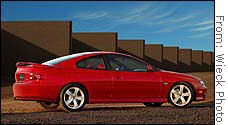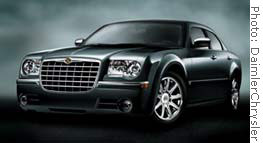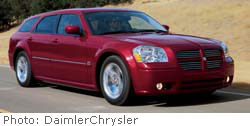NEW YORK (CNN/Money) -
Detroit is going back to the future by giving renewed attention to its cars' back wheels.
General Motors Corp. and Chrysler Group are making a new push toward rear-wheel-drive, a layout they moved away from more than a decade ago. Ford Motor Co. never moved as far away, but it also is increasingly using the old-time technology.
 |
|
| GM had to go to its Australian unit to get the rear-wheel drive for the new GTO. |
The new rear-wheel-drive effort is showing up especially on luxury and muscle cars in order to provide more power and performance and as an effort to hold off inroads by imports in the luxury car segment.
"It's a direct response to what we've seen Europeans and some Japanese companies doing," GM spokesman Michael Albano said. "They've done very well with luxury rear-wheel-drive cars."
It is perhaps ironic that the imports are taking Detroit back to rear-wheel-drive cars, because it was the imports that first brought front-wheel-drive vehicles to the forefront back in the 1970s. Front-wheel-drive cars boasted better fuel economy and more space in the passenger compartment because it wasn't necessary to have a transmission going from the engine compartment to the back wheels.
Front-wheel-drive cars also gained popularity because of better traction in bad weather, particularly snow and ice, due to greater weight over the wheels that propel the car. But Quinnell and other auto executives said that improvements in traction-control technology have lessened that advantage over time.
"The Big Three have moved away from rear-wheel drive but not the entire auto industry," Chrysler Group spokesman Cole Quinnell said. "Mercedes, BMW, some Lexus models have been rear-wheel drive.
 |
|
| Chrysler 300 |
"There are 4.2 million households which only own rear-wheel-drive vehicles," Quinnell noted. "There's a significant percentage of people who prefer this platform, whether it's a conscious decision or a preference they have without knowing why."
Rear-wheel drive balances the weight between the front and the back of the car more evenly, giving a car better cornering capabilities than front-wheel-drive vehicles. And since there's more room available in the front of the car, there is space available for a larger engine as well.
Totally turned around
The Big Three are adding rear-wheel drive primarily in the luxury car segment, not the mid-size family sedan (where import competitors still tend to have front-wheel drive). But GM's and Chrysler's moves show just how out of favor rear-wheel drive had become with those automakers.
This year, Chrysler is replacing its recently discontinued LHS, as well as its 300M and the Dodge Intrepid, with the new Chrysler 300 and Dodge Magnum.
 |
|
| Dodge Magnum |
They will be the unit's first volume rear-wheel-drive cars since 1989 -- only such low-production muscle cars such as the Dodge Viper and Chrysler Crossfire now have rear-wheel drive. Quinnell said much of the design of the new cars will be taken from Mercedes, which he said will help cut design costs and development time.
Pontiac has reintroduced the GTO for the first time since the 1960s. The rear-wheel-drive coupe is being imported from GM's Australian subsidiary because GM didn't have a U.S. rear-wheel drive system that would work on the muscle car.
GM also is increasing the use of rear-wheel drive on Cadillacs. The full-size front-wheel drive Seville is being replaced with the rear-wheel-drive STS. Cadillac also introduced the mid-size rear-wheel-drive CTS in late 2002.
Ford has stayed with rear-wheel drive on some large production cars, including its Crown Victoria and Mercury Grand Marquis as well as the Lincoln Town Car, which has allowed the company to dominate fleet sales to police departments, taxi and limousine companies. In high-mileage uses like these, front-wheel-drive cars are likely to have higher maintenance costs because of the more complex design required to have the front wheels both steer and provide power.
For its part, Ford discontinued the front-wheel-drive Lincoln Continental last year, shifting to the rear-wheel-drive Lincoln LS, which was introduced in 2000.
But a spokesman said the company probably is not ready to offer rear-wheel drive on large production family sedans like the Taurus.
"It's not necessarily a mainstream application," Ford's Dan Bedore said. "But for the person who likes the performance characteristics of rear-wheel drive, there's no replacement for that."
This story was original published in September, 2003. It has been updated.

|

